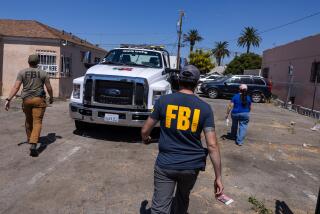Murky View Emerges of E. Europe Mobsters
First there was a trail of ransom demands and wire transfers from Moscow and the Middle East to New York and Los Angeles, the kind of path the FBI is expert at following.
Then there was the number of a stolen credit card belonging to one of five murder victims--faxed from a suspect’s home to a store in New York for $8,600 in video equipment, investigators say.
To law enforcement experts, those were glaring mistakes. Within three weeks, the FBI began rounding up members of a small group of suspected kidnappers--East European emigres operating mostly out of the San Fernando Valley.
And last week, the investigation of a botched kidnap-for-ransom scheme took agents to a murky reservoir in the Sierra foothills, where the bodies of five murder victims were found.
“Ransoms are normally paid in cash out in a field someplace,” said Larry Langberg, until recently the FBI’S top expert on East European crime in Los Angeles. The alleged kidnappers “made some errors that maybe fly in their old country, but don’t fly in this country.”
“I have to think if it was a really sophisticated group, they wouldn’t have left this trail that was so easy to trace,” he said.
But you never know, Langberg added. Like others knowledgeable about the crime scene in Los Angeles, he learned long ago that it can be difficult to easily describe the East European crime subculture.
And the strange tale of kidnappings and murders that surfaced last week after the discovery of five bodies in remote New Melones Lake in Calaveras County proved his point, he said.
Crime in Los Angeles involving immigrants from Russia and other East European countries once part of the Soviet bloc is viewed by most authorities here as more disorganized than organized.
It is largely a collection of small groups, all going their own way, the experts say. Not at all like the large criminal families associated with the Cosa Nostra or Mexican and Asian crime syndicates.
“The term Russian organized crime is a very elusive term,” said Larry Cho, head of the organized crime strike force in the U.S. attorney’s office in Los Angeles.
“There are very, very few true Russian syndicate cases,” Cho said. “It tends to be small groups of people acting without any coordination from above. And often it involves other East European groups.”
Despite media reports about the “Russian mob,” Langberg also cautioned that there usually is no clear structure to East European criminal activities in the Los Angeles area.
“In the states, a lot of East European criminals are just street hoods trying to make a buck,” he said. “There’s two possibilities in the case of the victims who were found in the lake.”
Those responsible “obviously are more than simple street thugs, because they have the knowledge of banking transactions,” he said. “But there is an unsophisticated side.
“They could be tied into a syndicate or some sort of organized crime. Or they could be a relatively low-level group of thugs with some connections back in Russia,” he said.
Langberg retired from the FBI two years ago after running the bureau’s Russian Organized Crime Squad in Los Angeles for five years. He estimates that there are about 300,000 to 500,000 immigrants in the area from countries that were once part of the Soviet Union.
The most common crimes he saw linked to East European groups involved fraud, Langberg said. During the mid-1990s, he saw several cases of medical fraud and some federal gasoline tax fraud. Extortion of businesses was also common.
Thom Mrozek, a spokesman for the U.S. attorney’s office in Los Angeles, agreed that the former Soviet bloc crime groups have a chaotic quality to them.
“It’s typically what I call ad hoc crime,” he said. “You have a bunch of knuckleheads together and they decide one day they will do a credit card. Then it’s something else. And something totally different after that.”
The growing problem of Russian crime in U.S. cities has drawn the most public attention in recent years. As early as 1996, the California attorney general’s office warned that it required special attention from law enforcement.
Such comments have touched off protests over the years from leaders of the Russian American community in Los Angeles, who have argued that talk of a Russian Mafia is unsubstantiated.
In fact, law enforcement officials say, members of the Russian underworld here frequently associate with criminals from other East European countries.
The largest Russian immigrant community in the United States is in the Brighton Beach area of Brooklyn. The Los Angeles area is the second largest, with sizable Russian immigrant communities in the Hollywood and Glendale areas. Those areas also have large communities of Armenians and other European groups.
“In New York, the Russians will not mix with other groups,” said federal prosecutor Cho. “But here you see Russians with Armenians or other groups....”
One trait common to the East European groups is that, organized or not, “the brutality can be pretty dramatic,” said Langberg.
“I remember one case in West Hollywood where there was a disturbance call,” he said. “When the sheriff’s deputies showed up, the guy comes to the door covered with blood, in the process of chopping up the people who had upset him for whatever reason.”
There are some signs that Eastern European crime groups are becoming more organized, especially in the New York area and especially within the growing Russian criminal subculture.
“There’s not a lot of evidence now of control of crime here by people back in Moscow,” said Langberg.
“But that could change if Moscow decides it’s good for business to send people over here to organize things,” he said.
More to Read
Sign up for Essential California
The most important California stories and recommendations in your inbox every morning.
You may occasionally receive promotional content from the Los Angeles Times.










